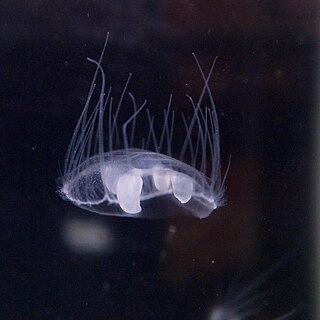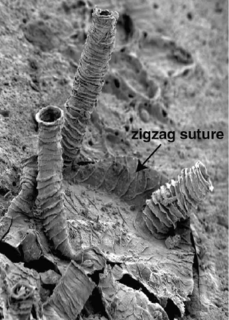 W
WAtolla wyvillei, also known as the Atolla jellyfish or Coronate medusa, is a species of deep-sea crown jellyfish. It lives in oceans around the world. Like many species of mid-water animals, it is deep red in color. This species was named in honor of Sir Charles Wyville Thomson, chief scientist on the Challenger expedition.
 W
WCassiopea ornata are one of many Cnidarian species called the upside-down jellyfish. This pelagic jellyfish primarily lives in tropical waters, off the coast of Australia in shallow lagoons and around mangrove trees. The name "upside-down jellyfish" comes from the fact that it appears to be upside-down in its natural state—resting on its bell. Its bell is a golden/brown color and the tentacles vary with different shades of yellow. While the sighting of this particular species is rare, it is usually mistaken for vegetation like the other species in genus Cassiopea.
 W
WCraspedacusta sowerbii or peach blossom jellyfish is a freshwater jellyfish in the phylum Cnidaria. Since it is classified as a hydrozoan, it is one of many jellyfish that are also known as hydromedusae. Hydromedusan jellyfish differ from scyphozoan jellyfish because they have a muscular, shelf-like structure called a velum on the ventral surface, attached to the bell margin. Originally from the Yangtze basin in China, C. sowerbii is an invasive species now found throughout the world in bodies of fresh water.
 W
WCyclocoeloma is a genus of crabs in the family Majidae, containing the single species Cyclocoeloma tuberculata.
 W
WFloresca is a genus of jellyfish in the family Ulmaridae It is monotypic with the type species Floresca parthenia.
 W
WLinuche aquila is a species of cnidarian found in the tropical and subtropical Pacific Ocean. It is very small and is commonly known as a thimble jellyfish because of its size and shape. The larvae can cause bathers to develop an itchy red rash commonly known as seabather's eruption.
 W
WNovodina americana is a species of starfish found of the coast of Greenland. A 2018 study of deep-water starfish species found that N. americana was both bioluminescent and, unexpectedly for an inhabitant of the aphotic zone, to have eyes that have among the highest resolutions found this far among starfish.
 W
WRaillietina echinobothrida is a parasitic tapeworm belonging to the class Cestoda. It is the most prevalent and pathogenic helminth parasite in birds, particularly in domestic fowl, Gallus domesticus Linnaeus, 1758. It requires two hosts, birds and ants, for completion of its life cycle. It is a hermaphrodite worm having both the male and female reproductive organs in its body. The parasite is responsible for 'nodular tapeworm disease' in poultry.
 W
WRhabdopleura compacta is a sessile hemichordate. It is a suspension feeder that secretes tubes on the ocean floor.
 W
WRhopalaea crassa is a species of tunicate belonging to the family Diazonidae.
 W
WSolaster dawsoni, the morning sun star, is a species of starfish in the family Solasteridae. It is found on either side of the northern Pacific Ocean. It has two subspecies:S. d. arcticus Verrill, 1914 S. d. dawsoni Verrill, 1880
 W
WSolaster stimpsoni, common names Stimpson's sun star, sun star, orange sun star, striped sunstar, and sun sea star, is a species of starfish in the family Solasteridae.
 W
WUlmaris is a genus of jellyfish in the family Ulmaridae.